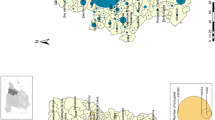Abstract
This paper shows that household location theory should probably be based on another foundation that the von Thunen-Muth-Alonso-Mills paradigm of location in relation to some predetermined market place or CBD. We argue that the formation of such centres is part of an interdependency analysis of the working of a metropolitan area. Such an interdependency principle is partially tested in this paper. Based on econometrically estimated parameters it has been possible to simulate the equilibrium structure of population in 1977 based on data from the Stockholm region in 1975. The fit is remarkably close and suggests that further development of this type of model is likely to be worthwhile.
Similar content being viewed by others
References
Alonso, W. 1964.Location and land use. Cambridge, Massachusetts: Harvard University Press.
Andersson, A. and Karlqvist, A. 1976. Population and capital in geographical space. The problem of general equilibrium allocation. InComputing equilibria: how and why, eds. J. Los and W. Los, 183–195. Amsterdam.
Artle, R. 1973, Cities as public goods. InProceedings of the symposium of studies on urban and regional systems, eds. S. de Julio and A. de Maio. University of Calabria.
Barr, J. 1976. Public goods, crowding and value equilibrium.Regional Science and Urban Economics 6, 1: 3–21.
Fisch, O. 1977. Spatial equilibrium with local public goods.Regional Science and Urban Economics 7, 3: 197–216.
Hicks, J. 1965.Capital and growth. Oxford: Oxford University Press.
Karlqvist, A. and Lundqvist, L. 1972. A contract model for spatial allocation.Regional Studies 6, 4: 401–19.
Koopmans, T. and Beckman, M. 1957. Assignment problems and the location of economic activities.Econometrica 25: 53–76.
Mills, E. and de Ferranti, D. 1971. Market choices and optimum city size.The American Economic Review 61: 340–45.
Muth, R. 1969Cities and housing. Chicago: University of Chicago Press.
snickars, F. 1972. Convexity and duality properties of a quadratic intraregional location model. Stockholm: Royal Institute of Technology, mimeographed.
Weibull, J. 1976. An axiomatic approach to the measurement of the accessibility.Regional Science and Urban Economics 6, 4: 357–79.
Author information
Authors and Affiliations
Rights and permissions
About this article
Cite this article
Andersson, Å.E., Ferraro, G.V.G. Accessibility and density distributions in metropolitan areas: Theory and empirical studies. Papers of the Regional Science Association 52, 140–158 (1983). https://doi.org/10.1007/BF01944099
Issue Date:
DOI: https://doi.org/10.1007/BF01944099




